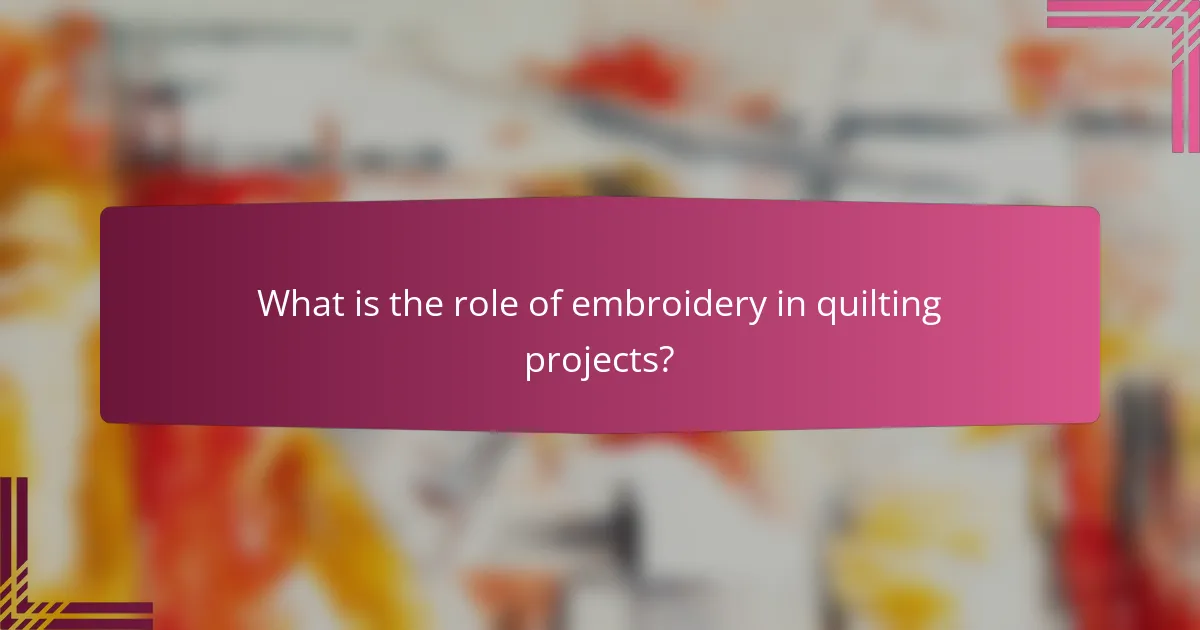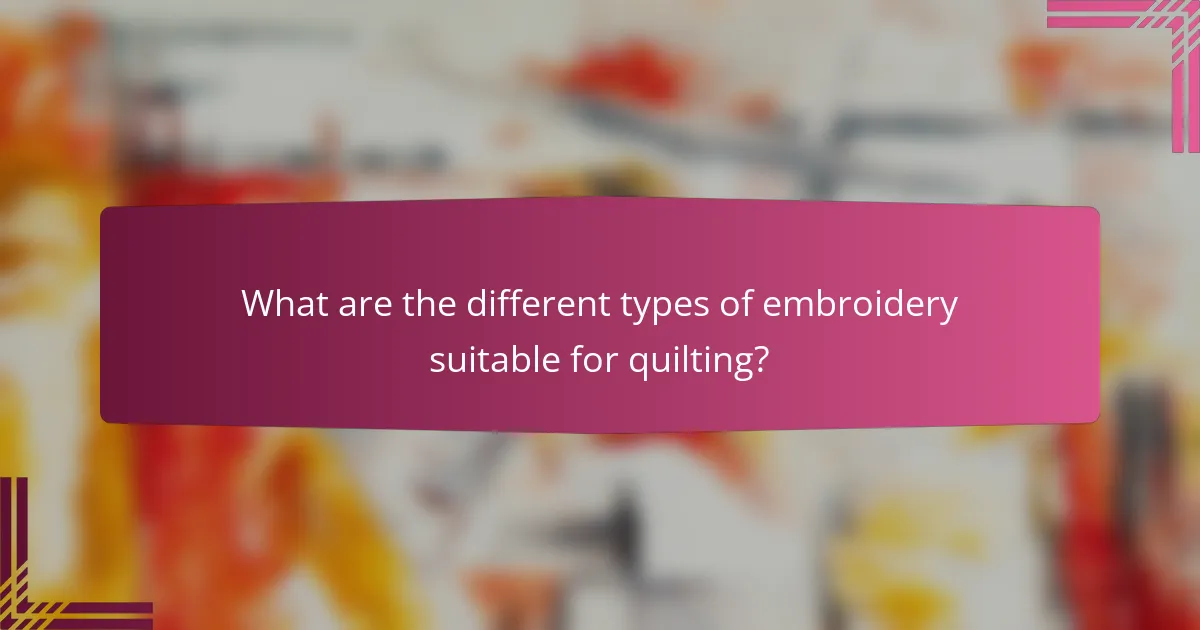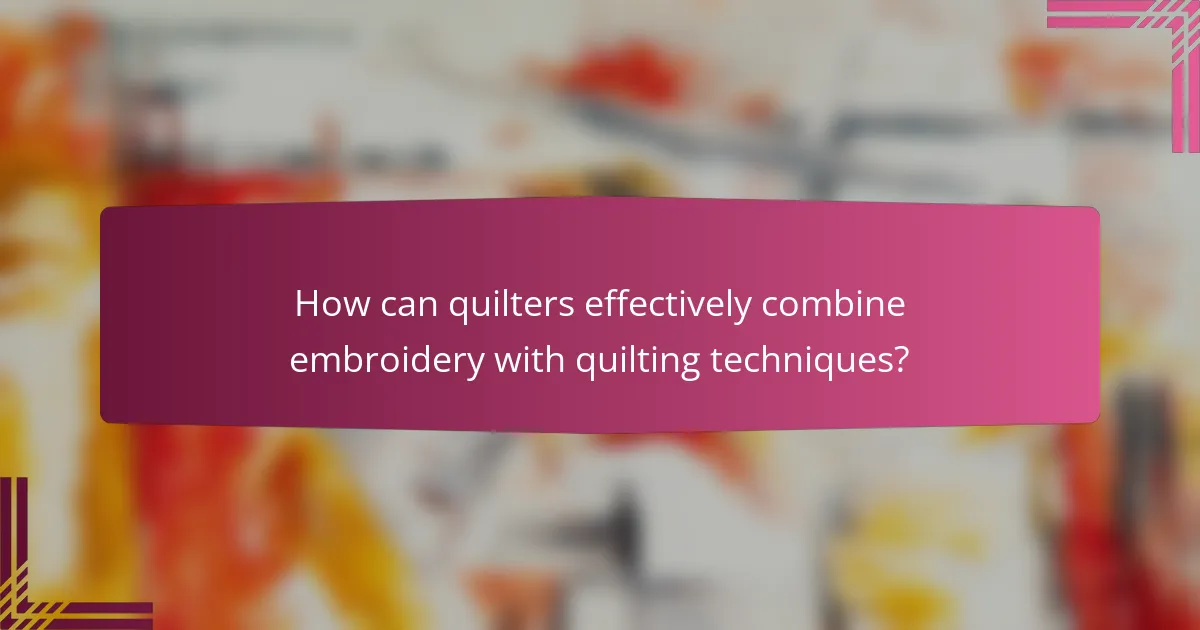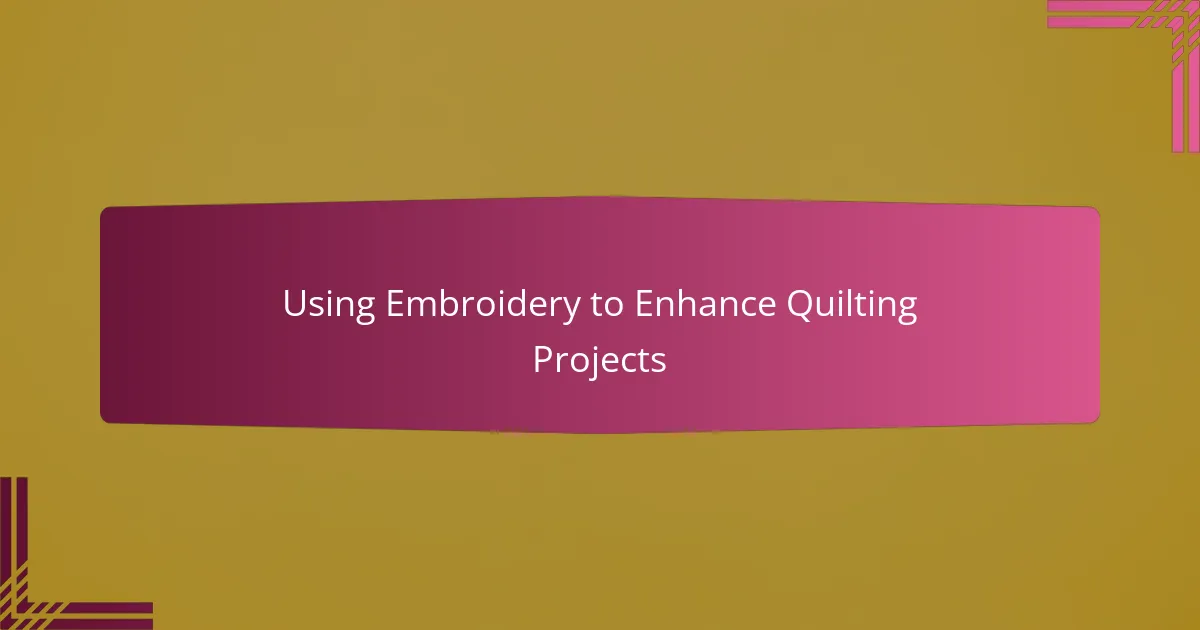
What is the role of embroidery in quilting projects?
Embroidery plays a significant role in quilting projects by adding decorative elements and personal touches. It enhances the visual appeal of quilts through intricate designs and patterns. Embroidery can also serve functional purposes, such as reinforcing seams or adding texture. Historical records show that embroidery has been used in quilting for centuries, showcasing craftsmanship and creativity. Specific techniques, like machine embroidery and hand stitching, allow for diverse artistic expressions. Quilters often use embroidery to tell stories or commemorate events, making each piece unique. This integration of embroidery elevates quilting from a practical craft to an art form.
How can embroidery enhance the overall design of quilts?
Embroidery enhances the overall design of quilts by adding intricate details and textures. It allows for personalization, making each quilt unique. Embroidery can highlight specific patterns or themes within the quilt. It also provides contrast, drawing attention to various fabric elements. Historical quilts often featured embroidery to showcase craftsmanship and artistry. Studies show that embroidered quilts can increase their aesthetic appeal and emotional value. The technique can incorporate various stitches and colors, contributing to a richer visual experience. Overall, embroidery serves as a complementary art form that elevates quilt design.
What specific embroidery techniques are commonly used in quilting?
Common embroidery techniques used in quilting include appliqué, embroidery stitches, and quilting motifs. Appliqué involves sewing fabric shapes onto a quilt background. This technique adds dimension and visual interest. Embroidery stitches, such as satin stitch and chain stitch, enhance the quilt’s surface. These stitches can be used for embellishment or to create intricate designs. Quilting motifs, including floral or geometric patterns, are often embroidered to unify the quilt’s theme. Each technique contributes to the overall aesthetic and texture of the quilt.
How does the choice of thread impact the final quilt design?
The choice of thread significantly impacts the final quilt design. Different threads can affect the texture, color, and overall visual appeal of a quilt. For instance, cotton thread provides a matte finish, while polyester thread can add sheen. The thickness of the thread also influences the quilt’s durability and texture. Thicker threads create more pronounced stitching, enhancing the design’s dimensionality. Additionally, color choices can either complement or contrast with the quilt fabric, altering the overall aesthetic. High-quality threads reduce fraying and improve stitch definition, ensuring a polished look. Therefore, selecting the right thread is crucial for achieving the desired design outcome in quilting projects.
Why should quilters consider incorporating embroidery into their projects?
Quilters should consider incorporating embroidery into their projects to enhance visual appeal and add texture. Embroidery can introduce intricate designs that elevate the overall aesthetic of a quilt. It allows for personalization, enabling quilters to express their unique style. Additionally, embroidery can strengthen seams and provide structural support to quilt layers. According to a study by the American Quilter’s Society, quilts with embroidery elements are often perceived as more valuable and desirable. This added dimension can also create focal points in quilt designs, drawing the viewer’s attention. Overall, integrating embroidery enriches the quilting experience and results in more distinctive creations.
What unique benefits does embroidery provide to quilting?
Embroidery provides unique benefits to quilting by enhancing visual appeal and adding texture. It allows quilters to personalize their projects with intricate designs. This personalization can make quilts more meaningful and unique. Embroidery can also reinforce seams and add structural integrity to the quilt. Additionally, it offers opportunities for creative expression through various stitches and patterns. The use of embroidery can elevate a simple quilt to a work of art. This combination of functionality and aesthetics makes embroidery a valuable addition to quilting.
How does embroidery affect the durability of a quilt?
Embroidery can enhance the durability of a quilt by reinforcing seams and fabric. The stitching creates additional layers that help prevent fraying and wear. This added structure supports the overall integrity of the quilt. Studies show that quilts with embroidery can withstand more stress than those without. The decorative stitches distribute tension more evenly across the fabric. This reduces the likelihood of damage over time. Additionally, the use of high-quality threads in embroidery contributes to longevity. Overall, embroidery not only beautifies quilts but also increases their functional lifespan.

What are the different types of embroidery suitable for quilting?
The different types of embroidery suitable for quilting include hand embroidery, machine embroidery, and applique. Hand embroidery allows for detailed designs using various stitches like satin and chain stitches. Machine embroidery uses computerized techniques to create intricate patterns quickly and consistently. Applique involves sewing fabric shapes onto a quilt, often enhanced with decorative stitching. Each type adds texture and visual interest to quilting projects. Hand embroidery is favored for its personal touch, while machine embroidery is valued for efficiency. Applique can create layered effects, making quilts more dynamic.
What are the most popular embroidery styles used in quilting?
The most popular embroidery styles used in quilting include appliqué, free-motion embroidery, and hand embroidery. Appliqué involves sewing a piece of fabric onto the quilt to create a design. This style allows for intricate patterns and shapes to be formed. Free-motion embroidery utilizes a sewing machine to create designs without a fixed pattern. This method offers flexibility and creativity in quilting. Hand embroidery, on the other hand, involves stitching designs by hand, providing a personal touch. Each style enhances the overall aesthetic of quilting projects.
How does machine embroidery differ from hand embroidery in quilting?
Machine embroidery differs from hand embroidery in quilting primarily in the method of application. Machine embroidery utilizes a sewing machine to create designs quickly and with precision. This technique allows for intricate patterns to be stitched in a shorter time frame compared to hand embroidery.
Hand embroidery, on the other hand, involves manually stitching designs using a needle and thread. This method often results in a more personalized and unique finish. Hand embroidery can showcase individual artistry through varying stitch techniques.
Machine embroidery typically offers more consistency in design and is ideal for mass production. It is also less physically demanding than hand embroidery. Conversely, hand embroidery can provide a tactile experience and a sense of craftsmanship that some quilters prefer.
Overall, the choice between machine and hand embroidery in quilting depends on the desired outcome and personal preference.
What are the advantages of using appliqué in quilting?
Appliqué in quilting offers several advantages. It allows for intricate designs and patterns that enhance visual appeal. The technique enables the use of various fabrics, adding texture and depth. Appliqué can be used to personalize quilts with names or motifs. It also provides opportunities for creative expression through color combinations. The method can be quicker than traditional piecing for certain designs. Additionally, appliqué can strengthen the quilt by reinforcing fabric edges. Overall, appliqué enhances both the aesthetic and structural qualities of quilting projects.
What tools and materials are needed for quilting with embroidery?
Quilting with embroidery requires specific tools and materials. Essential tools include a sewing machine with an embroidery function. A rotary cutter, cutting mat, and quilting ruler are also necessary for precise fabric cutting.
Materials needed are fabric, batting, and backing. Embroidery threads and stabilizers are crucial for achieving quality designs. Needles suitable for both quilting and embroidery should be included.
Additionally, an embroidery hoop helps secure the fabric during stitching. These tools and materials collectively enhance the quilting process and ensure successful outcomes.
What types of fabrics work best with embroidery in quilting?
Cotton fabrics work best with embroidery in quilting. Cotton is durable and holds embroidery stitches well. It is widely available in various weights and patterns. Lightweight cotton is ideal for intricate designs. Medium-weight cotton provides stability for larger motifs. Specialty cottons, like batiks, add texture and depth. Linen is another suitable option, offering a unique finish. It has a natural luster and is strong, but may fray more easily. Blends of cotton and polyester also work well, combining durability with ease of care.
How do different embroidery threads influence the quilting process?
Different embroidery threads significantly influence the quilting process by affecting the texture, durability, and visual appeal of the quilt. The choice of thread type, such as cotton, polyester, or silk, determines the overall strength and flexibility of the quilt. Cotton threads provide a natural look and feel, making them ideal for traditional quilts. Polyester threads, on the other hand, offer enhanced durability and resistance to fraying.
Silk threads add a luxurious sheen but may require careful handling. The thickness of the thread also impacts the quilting technique. Thicker threads create more pronounced stitches, while finer threads allow for intricate designs. Additionally, the color and finish of the thread can enhance the quilt’s design, creating contrast or blending with the fabric.
Using contrasting thread colors can highlight specific patterns, while matching colors can create a more subtle effect. Overall, the choice of embroidery thread plays a crucial role in the quilting process, influencing both functionality and aesthetics.

How can quilters effectively combine embroidery with quilting techniques?
Quilters can effectively combine embroidery with quilting techniques by integrating embroidered motifs into quilt blocks. This approach allows for unique designs and personalization of quilts. Quilters can choose to embroider before assembling the quilt or add embroidery to completed blocks.
Using a stabilizer during embroidery helps maintain fabric integrity. Selecting complementary thread colors enhances the overall visual appeal. Quilters often utilize techniques such as free-motion embroidery or machine embroidery for efficiency.
Research indicates that incorporating embroidery can increase the artistic value of quilts, making them more desirable. A study published in the “Journal of Textile Design” highlights that embroidered quilts often fetch higher prices at auctions. This evidence supports the notion that combining these techniques enhances both aesthetics and market value.
What are the best practices for planning an embroidered quilt design?
The best practices for planning an embroidered quilt design include selecting a cohesive theme and color palette. This ensures visual harmony throughout the quilt. Next, sketch your design ideas to visualize the layout. Use graph paper or digital tools for precision. Choose quality fabrics that complement your embroidery techniques. Pre-wash fabrics to avoid shrinkage later. Additionally, plan the placement of embroidery elements carefully to balance the overall design. Consider the quilting method you will use, as it affects the final appearance. Lastly, create a timeline for completing each section to stay organized. These practices enhance both the aesthetic and functionality of the quilt.
How should quilters choose placement for embroidery on their quilts?
Quilters should choose placement for embroidery based on design balance and visual appeal. Centered placements often draw attention and create a focal point. Quilters can also consider the quilt’s overall theme and color scheme. Placement near seams or borders can enhance the quilt’s structure. Additionally, quilters should think about how the embroidery interacts with other elements. Testing placements with fabric markers can help visualize the final look. Finally, considering the quilt’s intended use will influence placement decisions.
What techniques can be used to integrate embroidery into quilt blocks?
Techniques to integrate embroidery into quilt blocks include hand embroidery, machine embroidery, and appliqué. Hand embroidery allows for detailed designs and personal touches. This technique can include stitches like satin, backstitch, or French knots. Machine embroidery offers speed and precision. It can produce intricate patterns quickly with consistent results. Appliqué involves sewing fabric shapes onto the quilt block, often embellished with embroidery. This technique adds dimension and visual interest. Additionally, using embroidery as a quilting technique can enhance texture and pattern. These methods are widely used by quilters to create unique and personalized quilt blocks.
What tips can help quilters troubleshoot common embroidery issues?
To troubleshoot common embroidery issues, quilters should first check their thread tension. Incorrect tension can lead to thread breaks or uneven stitching. Quilters must also ensure they are using the correct needle type for their fabric. A suitable needle prevents fabric damage and improves stitch quality. Regularly cleaning the embroidery machine is essential to avoid lint buildup, which can cause skipping stitches. Additionally, using high-quality thread can minimize issues like fraying or breaking. Quilters should also verify that their design is compatible with the machine settings. Proper hooping techniques help maintain fabric stability during stitching. Lastly, reviewing the machine’s manual for specific troubleshooting tips can provide tailored solutions.
How can quilters prevent thread bunching during embroidery?
Quilters can prevent thread bunching during embroidery by ensuring proper tension settings on their sewing machine. Adjusting the upper and lower thread tensions can help maintain even stitching. Using high-quality thread reduces the likelihood of bunching. Selecting the correct needle type and size for the fabric is also essential. A needle that is too small can cause thread breakage and bunching. Additionally, using a stabilizer can support the fabric and prevent distortion. Proper hooping techniques help keep the fabric taut, which minimizes movement during stitching. Following these practices leads to smoother, more professional-looking embroidery results.
What steps can be taken to fix mistakes in embroidery on quilts?
To fix mistakes in embroidery on quilts, first identify the error. Common mistakes include misaligned stitches or incorrect colors. Once identified, carefully remove the faulty stitches using a seam ripper. Ensure to avoid damaging the fabric underneath. After removal, re-thread the needle with the correct thread color. Then, re-stitch the area, ensuring proper alignment and technique. Finally, inspect the corrected area for accuracy. This method is effective for maintaining the quilt’s overall appearance.
The main entity of this article is embroidery, specifically its role in enhancing quilting projects. The article explores how embroidery adds decorative elements, personal touches, and functional benefits to quilts, including reinforcement of seams and increased durability. It discusses various embroidery techniques such as hand and machine embroidery, appliqué, and their impact on quilt design and aesthetics. Additionally, the article addresses the importance of thread selection and placement for achieving desired outcomes in quilting, along with troubleshooting tips for common embroidery issues. Overall, the integration of embroidery elevates quilting from a practical craft to an art form, allowing for unique and meaningful creations.
